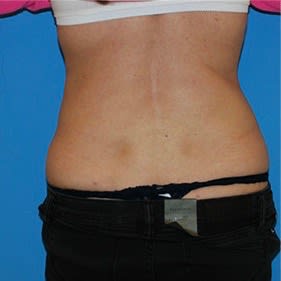
The Skinny
Overview
There are various types of abdominoplasty surgeries which have evolved considerably over the last decade and continue to improve every year. Today’s tummy tuck procedures are more effective than ever before—with more options available, less risk of complications, shorter recovery times, and much better results.
If you are considering a tummy tuck to re-shape your abdominal area, be sure to consult with a board-certified plastic surgeon to learn if you are a good candidate for the procedure. Read this guide to learn more about the surgery and whether a full abdominoplasty or a mini-abdominoplasty can help you achieve a better body.
AEDIT
Before & After Images by Provider
This Album Contains Explicit Content. Sign up or Login to Browse Real Before & Afters
Before & After Images by Provider
Tummy Tuck (Abdominoplasty) Solutions
The Specifics
Who is an Ideal Candidate for Tummy Tuck Surgery?
Your board-certified plastic surgeon can help you determine whether abdominoplasty is the right choice for you and your aesthetic goals. In general, ideal candidates for tummy tuck surgery share some important characteristics, which include loose, hanging, or sagging skin on the abdomen, and/or a separation of the muscles in the abdomen wall.
Additionally, an ideal candidate for tummy tuck surgery is in good health, is a non-smoker, and has realistic expectations regarding the benefits and possible outcome of abdominoplasty. He or she will also be within the ideal weight range for their height and body type and will understand the potential risk of complications during this surgery, as explained by their doctor.
Who is Not Recommended for Tummy Tuck Surgery?
Tummy tuck surgery is not for everyone, and patients should discuss their options with a board-certified plastic surgeon to determine whether this surgery is suitable for them. In general, candidates that suffer from certain illnesses or general health problems might not be suitable for an abdominoplasty. Patients should discuss their health history in full detail with their doctor during the initial consultation and should complete all medical testing as per the doctor’s requests to determine whether the surgery is suitable for them.
Patients should not use abdominoplasty surgery as a means to lose weight. Instead, tummy tuck surgery should be chosen as a last resort to remove stubborn fat and excess skin that is resistant to normal diet and regular exercise. Patients should have maintained a healthy, stable weight for at least a year before their surgery. Patients that are pregnant or are hoping to become pregnant in the future should not have an abdominoplasty until they have decided not to have more children.
How much does a tummy tuck cost?
The average cost of an abdominoplasty, according to the American Society of Plastic Surgeons (ASPS) was $6,092 in 2019. But there are possible additional expenses that should be considered when booking a tummy tuck. To better understand the price breakdown, check out our complete guide to tummy tuck cost.
How Should I Prepare for Tummy Tuck Surgery?
If you are considering have an abdominoplasty, your first step will be to schedule a consultation with a board-certified plastic surgeon. Your doctor will help you to understand the benefits and potential risks of the procedure, and how the surgery might help you achieve a smaller, more defined waistline. Be sure to discuss your full medical history with your doctor, and to answer all of their questions about your current state of health, past procedures, allergies, and other related concerns. If you are a good candidate for the procedure, you will be counseled on what to expect before the surgery happens and how to prepare for your surgical date.
Typically, most patients are given a physical examination to evaluate overall health and to determine treatment options. Your doctor will examine your abdomen and ask you questions about your weight loss plan if you are overweight, or questions about your diet and exercise routine if you have recently lost weight. Your doctor might want to photograph your abdomen to keep for your medical record and to compare your results before and after your surgery.
You will likely be asked to avoid taking anti-inflammatory drugs like aspirin and ibuprofen. Let your doctor know if you take any herbal supplements as well, to determine whether you should keep taking them before and immediately after surgery. Anti-inflammatory drugs and some herbal supplements can increase the risk of bleeding, which is why you will be asked to stop taking them before surgery. You may also be prescribed an anticoagulant that prevents blood clotting and other complications.
If you currently smoke, you will be instructed to stop smoking before and after surgery. Smoking inhibits blood flow and can interfere with the healing process. Smokers also have a higher risk of experiencing tissue damage from surgery. If necessary, ask your doctor for smoking cessation resources to help you follow through with your plan to quit smoking.
Finally, your doctor will ask you to arrange for a ride home from a trusted family member or friend after your procedure. This person should be able to stay with you for at least 24 hours after your surgery to help you with your recovery.
What are the Pros & Cons of a Tummy Tuck Procedure?
A tummy tuck can offer remarkable results for the right candidate and can mean a flatter, firmer stomach and tighter skin over the abdomen. Other benefits of a tummy tuck include the possibility of eliminating some or all existing stretch marks after weight gain/loss, a more attractive, leaner appearance, and increased self-confidence as a result of having a better-looking body.
That said, full abdominoplasty surgery is an invasive procedure, with a high risk of associated complications when compared to other cosmetic procedures. Mini and partial abdominoplasty surgeries are less invasive and offer a lower risk of complications however, patients will see less dramatic results. Patients considering having a mini or full abdominoplasty should be aware of the downsides to these procedures before deciding whether or not to have one.
Some common downsides to an abdominoplasty are visible and permanent scarring, long recovery times, and the risk of complications that could occur during or after surgery. Complications that can occur include infection, blood clotting, respiratory problems, and even death. It should also be noted that the risk of complications rises when surgery is combined with other cosmetic procedures, like liposuction, breast augmentation, or breast lift surgery—surgeries which are often performed together in a “mommy makeover.” You will also have an increased chance of experiencing certain complications if you suffer from existing conditions such as diabetes, heart, liver, or lung issues.
Pain and swelling are the most common side effects of abdominoplasty surgery. Your doctor will provide you a prescription for medication after your surgery that will help to manage the symptoms and relieve pain.
How Should I Choose a Plastic Surgeon?
The plastic surgeon you choose to perform your cosmetic procedure—whether an abdominoplasty, a breast augmentation, breast lift, or another kind of body lift—should be a qualified, board-certified physician licensed in your state to perform the surgery you want to have. The success of your results will depend heavily on the quality of your doctor, so make sure to take the time to research your options before choosing the best one. Check out online reviews for doctors that are recommended by reputable organizations like the American Board of Plastic Surgery or the American Society of Plastic Surgeons.
What Kinds of Abdominoplasty Surgeries Are There?
There are various surgical techniques that a board-certified plastic surgeon might use during an abdominoplasty procedure. The one chosen for your surgery will depend on the physical characteristics and needs of the patient. In any case, there are two types of tummy tuck procedures: a full abdominoplasty and mini or partial abdominoplasty.
Determining which procedure is the right choice for you is an important step to take before deciding to have an abdominoplasty. A board-certified plastic surgeon will take into consideration the patient’s body weight, the amount of excess abdominal skin on the patient’s torso, the area where the skin is located (upper abdomen or lower), and other details to decide on the best technique on a case-by-case basis.
Traditional Tummy Tuck
The traditional tummy tuck, also known as a “complete” or “standard” abdominoplasty, is the most invasive type of tummy tuck procedure, typically used in cases where the patient has a large amount of excess skin to remove after losing weight. The doctor will make a long, vertical incision over the groin that reaches from one hip to the other. Another incision will then be made to separate the navel area from the layer of soft tissue below, and the flap of skin will be dissected and retracted back to reveal the fat and muscle tissue.
Complete abdominoplasty is usually ideal for those suffering from diastasis recti, a common post-pregnancy condition where the muscle wall is lax or has been separated and requires repair. The plastic surgeon will then suture the separated abdominal muscles together to tighten them, and will also remove excess skin and fat tissue. Once this has been completed, the surgeon will replace the layer of skin over the exposed abdomen, re-create the navel opening, and close the incision with sutures.
Partial or Mini Tummy Tuck
Patients that have minimal abdominal muscle separation (diastasis recti) or have limited excess sagging skin might benefit more from a partial or mini tummy tuck than a full abdominoplasty, which is more invasive. In a partial or mini tummy tuck, the focus is on tightening the skin on the lower abdomen. No incisions or adjustments are made to the navel in a partial or mini tummy tuck, as opposed to a traditional or full abdominoplasty where the belly button is moved and recreated. This procedure is most helpful for body contouring and skin tightening purposes in cases where only the skin beneath the belly button is slightly sagging or has lost laxity after pregnancy or weight loss.
What Should I Do to Help My Recovery After Surgery (Post-Surgery After-Care)
It can take anywhere from four to six weeks to recover completely after an abdominoplasty, depending on the invasiveness of the procedure. During this time, you will be advised to limit your activity and eliminate any strenuous exercise that might interfere with your healing process. Take time to get up and walk slowly around the house at regular intervals throughout the day to keep your blood flowing and to prevent blood clotting. You will likely need to take a few weeks off from work and your usual daily activities.
It is critical that patients that have had abdominoplasty surgery follow the instructions given to them by their surgeon regarding their after-care. Whether your procedure consisted of a mini or a complete abdominoplasty, your doctor will have closed the incision made to your abdomen with stitches, and the wound will be covered in bandages. You will be carefully instructed on proper movement when sitting and lying down, and how to keep from disrupting your stitches.
To better understand the healing and downtime associated with the procedure, check out our complete guide to tummy tuck recovery.
The Takeaway
Conclusion
Remember, not only is your physical appearance on the line when you consider having plastic surgery—but you are also placing your health and well-being in the hands of your doctor. Talk to several surgeons and choose the one you feel the most comfortable with while making sure they have a lengthy track record of success in the surgery you are interested in having.
According to statistics gathered by the American Society of Plastic Surgery, tummy tucks were the fifth most popular cosmetic surgical procedure performed in 2017. While the procedure itself can be slightly riskier than other cosmetic surgeries, today’s tummy tucks are generally safe and effective and boast a high satisfaction rate from patients that have had the surgery. If you are interested in improving your appearance with a thinner, firmer waistline, ask a board-certified plastic surgeon about abdominoplasty and whether the procedure might be suitable for you and your aesthetic goals.











